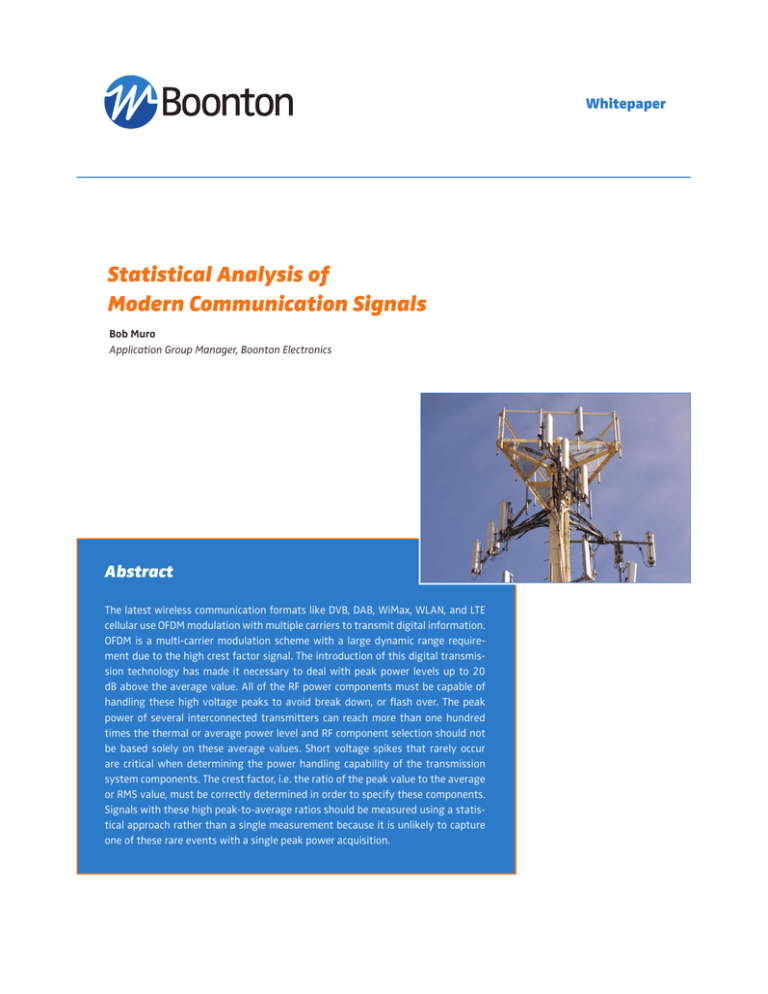Statistical Analysis of Modern Communication Signals
advertisement

Whitepaper Statistical Analysis of Modern Communication Signals Bob Muro Application Group Manager, Boonton Electronics Abstract The latest wireless communication formats like DVB, DAB, WiMax, WLAN, and LTE cellular use OFDM modulation with multiple carriers to transmit digital information. OFDM is a multi-carrier modulation scheme with a large dynamic range requirement due to the high crest factor signal. The introduction of this digital transmission technology has made it necessary to deal with peak power levels up to 20 dB above the average value. All of the RF power components must be capable of handling these high voltage peaks to avoid break down, or flash over. The peak power of several interconnected transmitters can reach more than one hundred times the thermal or average power level and RF component selection should not be based solely on these average values. Short voltage spikes that rarely occur are critical when determining the power handling capability of the transmission system components. The crest factor, i.e. the ratio of the peak value to the average or RMS value, must be correctly determined in order to specify these components. Signals with these high peak-to-average ratios should be measured using a statistical approach rather than a single measurement because it is unlikely to capture one of these rare events with a single peak power acquisition. Statistical Analysis of Modern Communication Signals Statistical Methods Example Measurements Low amplitude communication signals with a high crest factor, although important when considering bit error rate (BER), are of greater concern for their contribution to system damage. The high voltage associated with large power peaks can produce flashover, or a standing arc in the transmitter system and destroy components. Statistics are an important tool for measuring these rare events. The instantaneous power values are sorted by magnitude rather than their time of occurrence, and are counted rather than averaged. This process can run for a very long time, limited only by available memory, or indefinitely if decimation is applied. It is an invaluable method for characterizing events, such as the maximum peak power of an OFDM signal that might occur only once per day. Capturing pulse data using statistics provides additional insights not easily observed when capturing amplitude vs. time measurements. Figure 1 shows a real world CCDF of an HDTV, OFDM modulated signal. Trace A shows a 100% AM modulated sine wave, which has a “squared off” CCDF showing a peak-to-average ratio of 3 dB at both low and high probabilities. This is due to the highly predictable periodic waveform. The OFDM signal shown in Trace B has a peak-to-average ratio of about 15dB, and follows a Rayleigh distribution pattern. Trace C shows white, Gaussian noise for reference, which theoretically has an infinite peak-to-average ratio, but shown here with about 17 dB for a probability of 10e-12. Figure 2 is an illustration of the PDF, or probability density function of a 16 QAM modulated digital signal. Levels, 1, 2, and 3 represent the three distinct power levels of a 16 QAM signal. The data signal is a Pseudo-random bit stream (PRBS) pattern that in theory has a uniform distribution of bit values. Figure 3 is the constellation diagram of a 16 QAM signal that illustrates the 3 distinct power levels using a polar plot. Because power level two has 8 possible bit locations the number of occurrences should be twice that of levels one and three. 10 A = CCDF of sine-wave 0 16 QAM Conste 16 QAM Power Histogram PRBS Pattern Amplitude Level 3 0011 Level 2 AB 0001 0000 1x 2x # of occurrences Figure 2 probability p 16 QAM Constellation Diagram 16 QAM Power Histogram PRBS Pattern Power Level Three -8 10-10 B CD C Level 3 0011 0111 +3V 11 1011 Power Level Two 1111 +2V 10-12 Level 2 -14 10 0 2 4 6 8 10 12 AB 14 16 18 20 +1V 0110 01 0010 00 -3V k in dB above average 0001 -2V Power Level One 10 +1V -1V 0101 1110 11 1010 10 -1V 01 1001 +2V AB +3V 1101 -2V Level 1 Figure 1 - CCDF of a sinusoidal signal (carrier approach), an OFDM envelope signal and for white noise. 0000 0100 W 00 1000 1100 CD For the AM modulated signal, it is clear that a few hundred 1x only 2x samples must be acquired to measure the signal’s peak power, # of occurrences while the digital OFDM signal has peak excursions that can occur once in 10 billion times. For these signal types, the power meter must acquire many samples over a period of time to accurately characterize the power distribution. Whitepaper -1V -1 0101 -2 10-4 Amplitude -2V Level 1 -2 A + 0110 01 0010 00 -3V 10 10 + + B = OFDM envelope C = white noise 10-6 0111 Figure 3 Statistical Analysis of Modern Communication Signals 2 0100 Pmax Amplitude 25.5 dBm Amplitude PDF 23 dBm CCDF CDF 16 dBm Pmin 0% Probability 100% 0% Probability 100% Figure 4 - PDF, CDF, and CCDF diagram For communication purposes it is often desirable to view the maximum power value in a CCDF, or complementary cumulative distribution function. This is accomplished by integrating the PDF to create a CDF, or cumulative distribution function as illustrated in Figure 4. The CCDF, or complementary cumulative distribution function is calculated by subtracting the CDF from one (1 - CDF = CCDF). This distribution has the highest peak values (which have the lowest probability of occurrence) displayed at the upper left corner of the graph. In the first wireless LAN (WLAN) signal example, the continuous, free-running acquisition process will gather samples during both the active and inactive (off) signal intervals, distorting the CCDF (Figure 5 Top). Note that the power quickly falls off above about 62% probability, indicating the signal is spending more than 1/3 of the time at low or “off” power levels. In a time-slotted or bursted signal such as WLAN, this is expected because the transmitter is turned off between signal packets. To provide a meaningful CCDF for time-synchronous signals, an advanced peak power meter should have a time-gated statistical mode, which limits the statistical acquisition to certain portions of the waveform. This ability permits exclusion of off time, and preamble, and results in a CCDF which accurately reflects the power distribution during the more random “payload” portion of the frame. Figure 5 shows the same WLAN burst in the lower trace window with time-gate cursors being used to define the region of interest for CCDF analysis. The CCDF in the lower trace window is computed for the WLAN payload, and is no longer skewed by the low-crest-factor preamble and the off intervals between bursts. Note that the X axis in both examples uses linear scaling of probability, which results in a rising “tail” as the CCDF curve approaches zero probability (the absolute peak power). This tail is the region of most interest to RF engineers, and using logarithmic scaling for the CCDF straightens out the “tail” as it approaches the axis. This is a more useful display format because it expands the very low probability events of interest. This is the region where signal compression can increase the bit error rate of digitally modulated communication signals. Whitepaper Limiting the time gates to the preamble area illustrates the low peak power values, and constant power envelope in contrast to the data section of the signal. Statistics are important when measuring modern communication signals because of their high peak-to-average ratio or crest factor. The crest factor is an important signal parameter and can be calculated and displayed using a CCDF. Figure 5 - CCDF power meter screen captures showing probability on the X axis and absolute power in dBm on the Y axis. Statistical Analysis of Modern Communication Signals 3 Alternate Statistical Display Figure 6 - Screen captures using log scaling of the X axis. Limiting the time gates to The CCDF is often presented in a normalized, log-log display format, with power values shown in dB relative to the signal’s average power. This is helpful for comparing the CCDF at different points in the signal chain because a particular signal will exhibit a welldefined CCDF regardless of the absolute power level. Measurement instrumentation often has the signal amplitude displayed on the Y axis, but a typical communications textbook CCDF is shown with the log probability on the Y axis and normalized power on the X axis. This rotated, normalized presentation is becoming more common in practice and is configured on the latest power meters. The example in Figure 7 shows the CCDF of a WCDMA signal displayed on a Boonton 4542 peak power meter. The CCDF is displayed using the rotated and normalized presentation format – with log probability on the Y axis and crest factor (normalized peak power) on the X axis. The left end of the Y axis is 0 dBr, which corresponds to the signal’s long-term average power. The theoretical maximum peak occurs at 0% probability, which is undefined on the log presentation. The trace intersects the X axis (0.0001%, or 10e-6 probability) at a crest factor of about 15 dBr. This demonstrates that one sample out of every one million would be expected to exceed the average power by more than 15 dB. As the probability decreases, the crest factor will continue to increase by a small amount. The slope of the CCDF near the bottom of the screen indicates that several more decades would add ≤ 1dB of higher crest factor. the preamble area illustrates the low peak power values and constant power envelope in contrast to the data section of the signal. Statistics are important when measuring modern communication signals because of their high peak-to-average ratio or crest factor. The crest factor is an important signal parameter and can be calculated and displayed using a CCDF. Whitepaper Statistical Analysis of Modern Communication Signals 4 Dual CCDF Displays Frequent Events Increasing Probability Infrequent Events Increasing Crest Factor Figure 7 - Rotated and Normalized CCDF display with Log-Log scaling Frequent Events The Boonton 4540 series peak power meters include a dual CCDF feature that allows comparison of the input and output power distributions of an RF device such as a power amplifier. The comparison in Figure 8 shows the crest factor deviation between the input (Ch2, blue, on the right) and output (Ch1, yellow, on the left) of the amplifier. Because the signal being amplified is the actual communication signal, it contains all the frequencies and power levels of interest allowing evaluation of the amplifier over its entire dynamic range. This gives designers the opportunity to measure amplifier performance with the “real” signal rather than using a CW tone to estimate performance with a figure of merit like the 1dB compression point. The CCDF is more useful than a simple, crest-factor measurement as it quantifies the amount of compression at various probability levels. The BER and CCDF data can be correlated using a proto-type receiver circuit that contains the DUT amplifier during initial qualification. This would be useful for preliminary testing of the amplifier’s performance before they are assembled into receivers during transmitter production. Conclusion Increasing Probability Infrequent Events Increasing Crest Factor Amplifiers that transmit wireless communication signals with large peak-to-average power ratios should be evaluated for their peak power performance. A Peak power meter with statistical measurement capability is an important tool for this evaluation. The PDF, CDF, and CCDF displays provide important information about the maximum peak power values to help designers avoid communication system damage by correctly sizing the RF components. The Boonton 4500B and 4540 series peak power meters are designed with these advanced features to properly analyze the amplifiers that transmit these high crest factor communication signals. Figure 8 - Dual CCDF “input/output” display shows the output has a reduced crest factor, indicating signal compression. Whitepaper Statistical Analysis of Modern Communication Signals 5 Wireless Telecom Group Inc. 25 Eastmans Rd Parsippany, NJ United States Tel: +1 973 386 9696 Fax: +1 973 386 9191 www.boonton.com Follow us on: WTGinnovation Wireless Telecom Group blog.wtcom.com WTGinnovation B/WP/0412/EN Note: Specifications, terms and conditions are subject to change without prior notice.





